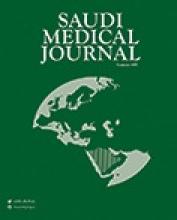Abstract
OBJECTIVE: To investigate the validity of a new approach to assess the cervical vertebral maturation based on angular measurements of the lower border concavity of cervical vertebral bodies.
METHODS: Hand-wrist and lateral cephalometric radiographs of 197 male subjects with age range of 10-15 years attending the orthodontic clinic at King Saud University, Riyadh, Kingdom of Saudi Arabia were utilized. The study was carried out between September 2009 and May 2011. The study sample was divided into 6 groups (group 1: 10 years to group 6: 15 years) based on the chronological age of the subject. The skeletal age of the subjects was determined using Greulich and Pyle's standard radiographic atlas, and skeletal maturation was assessed by Fishman's skeletal maturity indicators. The cervical vertebral maturation (CVM) of subjects was determined using angular measurements of the second, third, and fourth cervical vertebral bodies. The validity of the newly developed method was assessed by examining the correlation between CVM stages determined by the angular measurements and the skeletal maturation level as determined by the standard hand-wrist methods.
RESULTS: A significant correlation (r=0.94) was found between the angular CVM stages and the skeletal age determined by Greulich and Pyle's atlas from hand-wrist radiographs. Also, a high correlation (r=0.94) was found between the angular CVM stages and the Fishman's hand-wrist skeletal maturity indicators.
CONCLUSION: The new angular measurement approach to determine CVM is valid and has the potential to be applied in assessing skeletal maturity level in growing male children.
- Copyright: © Saudi Medical Journal
This is an open-access article distributed under the terms of the Creative Commons Attribution-Noncommercial License (CC BY-NC), which permits unrestricted use, distribution, and reproduction in any medium, provided the original work is properly cited.






